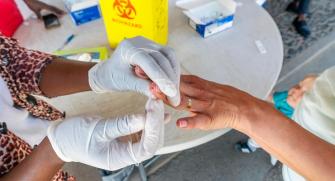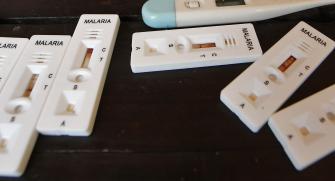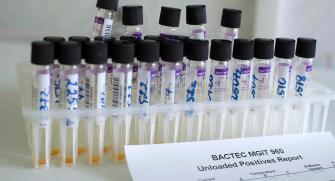Verbal autopsy, an additional tool for epidemiology
What is the context of your study and where is it taking place?
 Lise Grout: The very violent conflict in Ituri, a province in the northeast of the Democratic Republic of Congo (DRC), since 2017 has resulted in massive population displacement, and high mortality from violence, but also from malaria. The mortality rate for children under five in the area (both natives and displaced) appears to be above the emergency threshold, with malaria, anemia, and diarrheal diseases the main causes. The year 2020, marked by heavy rains and the COVID19 pandemic that could have weighed on a fragile health system, predicted even higher malaria mortality. MSF therefore decided to carry out a mass drug administrations of antimalarial (MDA) in a part of the Angumu health zone where many IDPs are located and where MSF has a regular project since 2019.
Lise Grout: The very violent conflict in Ituri, a province in the northeast of the Democratic Republic of Congo (DRC), since 2017 has resulted in massive population displacement, and high mortality from violence, but also from malaria. The mortality rate for children under five in the area (both natives and displaced) appears to be above the emergency threshold, with malaria, anemia, and diarrheal diseases the main causes. The year 2020, marked by heavy rains and the COVID19 pandemic that could have weighed on a fragile health system, predicted even higher malaria mortality. MSF therefore decided to carry out a mass drug administrations of antimalarial (MDA) in a part of the Angumu health zone where many IDPs are located and where MSF has a regular project since 2019.
This is the administration of a full course of antimalarial drugs (regardless of the presence of symptoms or infection) to a defined population living in a defined geographical area at approximately the same time and often repeated at regular intervals-as recommended by WHO in complex emergency settings. It was conducted in 3 rounds, with in October and November 2020, 2 rounds of ASAQ which combine artesunate-amodiaquine and in December 2020, 1 round of Pyramax, artesunate-pyronaridine combination.
At the end of this MDA, in March 2021, we conducted a survey of 2,500 households to compare mortality rates between September 2020 and March 2021 in health areas with MDA and those without MDA, before (September 2019/September 2020) and after (October 2020/March 2021) the MDA. Household heads were interviewed to find out, among other things, how many people had died in their households since September 2019.
What were the first results?
L.G.: A first very satisfactory result concerns the distribution coverage rate: it is above 90% in the villages and 96% in the IDP camps, which illustrates the good adherence of the population. However, what the survey especially highlighted was a spectacular reduction in malaria mortality among children under 5 years of age after the MDA: the mortality rate was up to twice as high in the health areas where the MDA had not been practiced.
Behind this very encouraging result, however, was the question of its sustainability over time. Would mortality rise slowly? or would we see a rapid return to the initial mortality? or even a rebound in mortality as the most pessimistic predicted. A second survey was therefore conducted one year later in April 2022, with much less clear-cut results.
In two of the four health areas where the MDA had taken place, mortality was still lower than in the areas without the MDA, but in the other two, it was higher. Even more surprisingly, malaria was still the main cause of death according to household heads, and the deceased were older than in the other health areas.
A closer look at the data showed that this excess mortality was visible from the beginning of 2021 (just after the MDAs) and seemed to affect certain villages and IDP camps in particular. This led us to make several hypotheses:
- either it was an interviewer bias (some interviewers collected data differently or incorrectly)
- or the deaths did not correspond to household members, but rather to people visiting the households surveyed
- or the excess mortality was real.
In the latter case, we wanted to understand whether the primary cause of death was malaria, as reported by household heads, or whether some other condition may have been present in the area during the recall period. The only way to answer this question was to return to the villages and IDP camps with a more powerful tool to learn more about the causes of the 400 deaths reported in April, and verbal autopsy seemed to be the right tool.
What is a verbal autopsy?
L.G: In the absence of death registers and civils-status, it is difficult to establish the cause of death. The verbal autopsy was developed by WHO to fill this gap and to collect information weeks or even months after a person's burial. It is a standardized clinical questionnaire lasting 20 to 30 minutes. Using a tablet, an investigator collects from the families the circumstances of the death, the description of the symptoms and clinical signs that preceded the death, the care pathway (laboratory tests, treatment) of the person, some existing risk factors, and asks if a death certificate exists. These data are then analyzed, either by a physician with regard to the local epidemiological context, which will enable him to establish a differential diagnosis and the probable cause of death, or by an algorithm developed by researchers specialized in the subject and validated by the WHO.
We sent investigators to find the deaths reported in April 2022 and perform the verbal autopsy. We had to deal with absences and relocations (especially for displaced persons) but relatively few refusals. A pool of physicians at MSF and Epicentre has been formed to decipher the questionnaires and determine probable causes of death. This work is ongoing.
If verbal autopsy proves feasible in fields where MSF and Epicentre are working and confirms its effectiveness in determining probable causes of death more accurately, it could be incorporated into the MDA impact follow-up survey planned for April 2023, or into other retrospective mortality surveys for which it might be deemed useful.
It is only at the end of all these analyses that we can really decide on the medium-term effect of the MDA in Ituri.










